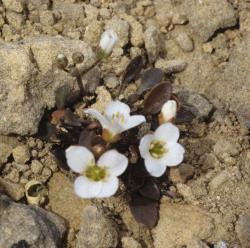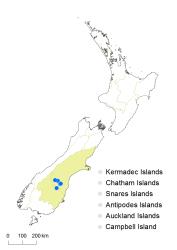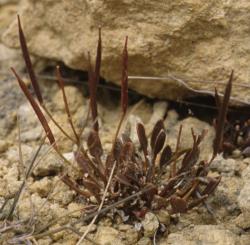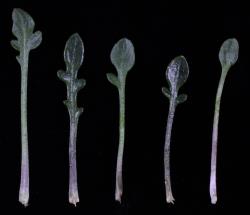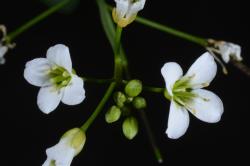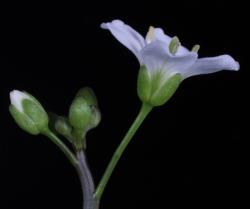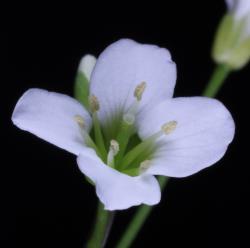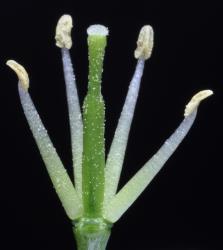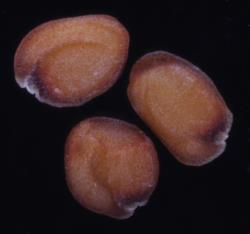Perennial herb, single rosette or multiple rosettes on short lateral branches, stem and branches up to 3.5 mm diam. Leaves up to 115 mm long, simple, pinnatifid or pinnatisect; lamina 4.3–34.0 × 2.5–13.5 mm, red-brown to brown, occasionally green, glabrous, glabrate or sparsely hairy, glossy, coriaceous, ovate, obovate or oblong; apex obtuse, the hydathode distinct or indistinct; base cuneate, occasionally ± obtuse or attenuate; margin entire or sometimes with 2–4 irregular basal lobes or pinnae; margin and adaxial surface occasionally with hairs up to c. 0.4 mm long; petioles up to 95 mm long, plano-convex, glabrous. Cauline leaves absent. Inflorescences racemose or flowers in loose whorls, often branched, 4–20-flowered; up to 150 mm high, up to 1.2 mm diam. at base, upright, glabrous, green, red-brown to brown. Pedicels up to 30 mm long, c. 0.6 mm diam., stout, glabrous. Sepals 2.3–3.1 × 1.3–1.8 mm, oblong to oval, ± saccate, green, green-brown to red-brown, glabrous, margin white and membranous, apex obtuse, base truncate. Petals 7.0–10.5 × 2.7–5.5 mm, white, limb obovate; apex obtuse; base attenuate, tapering to a 1.0–2.0 mm long claw. Stamens 6, linear along their length, 0.15–0.3 mm wide; median filaments 4, 3.3–5.5 mm long, lateral filaments 2, 2.2–4.8 mm long; anthers 0.6–1.3 mm long, maroon or yellow and flushed maroon, held below or at a similar height to the stigma. Ovary 2.3–6.0 mm long, 0.6–0.8 mm diam., terete, green, glabrous; ovules 24–34; style 1.0–1.8 mm long, terete, compressed slightly; stigma 0.5–0.7 mm diam. Siliques 10.0–29.0 × 1.2–1.7 mm, upright, glabrous, valves brown or green-brown at maturity, style 1.7–3.5 mm long, replum 0.3–0.4 mm wide. Seeds 1.0–1.3 mm long, 0.9–1.0 mm wide, 0.4–0.5 mm thick, orbicular to oblong, henna; wing absent.
South Island: Canterbury, Otago.
Cardamine bilobata occurs in North Otago and South Canterbury, with early collections indicating it was once common in the vicinity of Kurow, Waitaki River valley, but it is currently known from only one site at Awahokomo limestone (near Kurow). Two collections from Mt Edward, South Canterbury, may be referable to C. bilobata or C. dimidia as they have leaves with a large, elongate terminal lobe and smaller basal lobes; flowering plants from this area are necessary to confirm their identity (Heenan 2017).
Cardamine bilobata grows in shallow limestone soils at Awahokomo.
Cardamine bilobata is assessed as having a conservation status of Threatened, Nationally Critical (A1), with the qualifiers Conservation Dependent and Data Poor (de Lange et al. 2018). The qualifier Conservation Dependent is applied because at the largest known population at Awahokomo limestone outcrop (North Otago) hand weeding is regularly undertaken to control naturalised species. Data Poor is applied because further field surveys are required to locate additional populations, and in particular to revisit sites where C. bilobata has previously been collected (e.g., West Eweburn Dam, North Otago).
Flowering September–December; Fruiting September–December.



